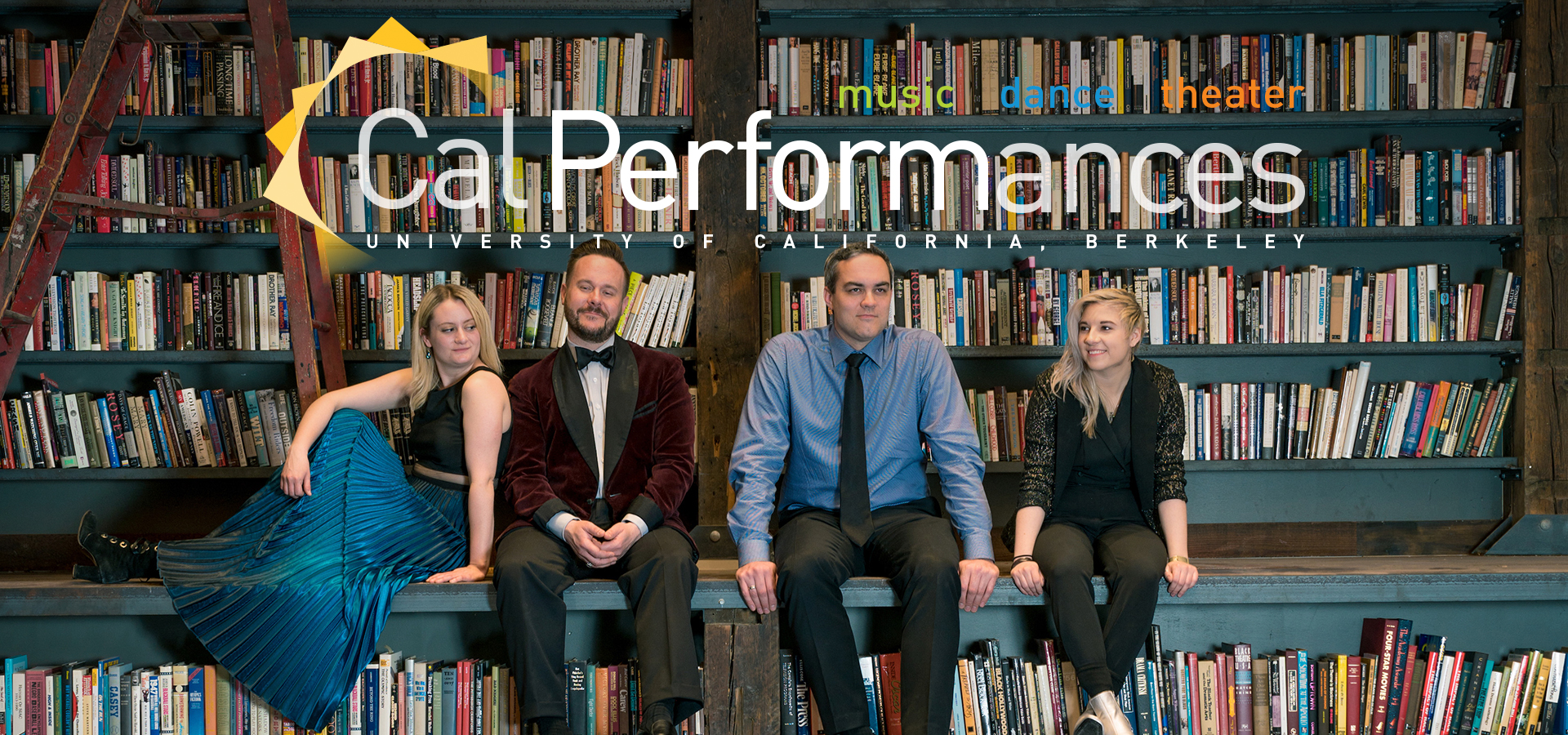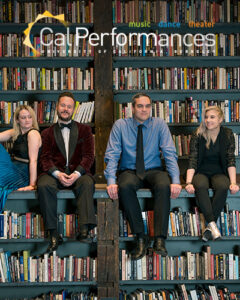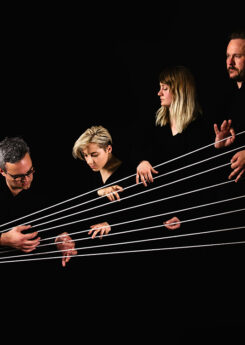Spektral Quartet
Sunday, February 13, 2022, 3pm
Hertz Hall
Clara Lyon, violin
Maeve Feinberg, violin
Doyle Armbrust, viola
Russell Rolen, cello
From the Executive and Artistic Director

Welcome to this afternoon’s concert with the marvelous Spektral Quartet. As usual, this bold and innovative ensemble arrives with a program designed to illuminate the connections between beloved works in the canon and fresh new repertoire by living composers. The group’s Berkeley debut (following last season’s online performance with American vocalist, flutist, and composer Nathalie Joachim) features the world premiere of a new work by Samuel Adams, along with Schubert’s haunting Rosamunde Quartet, and Philip Glass’ Company Quartet. Spektral Quartet recently announced that this season will be its last, capping a remarkable 11 years as one of America’s most adventuresome string ensembles. Their final performances will take place this summer, so I’m very happy that today, we can all enjoy this chance to experience the music-making of these four gifted artists.
While we at Cal Performances like to think of each of our programs as unique and remarkable, next week offers another season highlight when co-producers and stars Alicia Hall Moran (mezzo-soprano) and Jason Moran (piano) arrive on campus for the West Coast premiere of their brilliant Two Wings: The Music of Black America in Migration (Feb 17, Zellerbach Hall), a series of “gripping portraits of a vast social upheaval” (Chicago Tribune) that explores the Great Migration of six million Black Americans from the rural South to northern cities, the West, and beyond. This ambitious production (a Cal Performances Illuminations “Place and Displacement’ presentation) features a star-studded roster of guest performers, writers, and thinkers, headed by composer/conductor (and 2021 winner of the Pulitzer Prize for Music) Tania León, narrator Donna Jean Murch (author of Living for the City), and the Imani Winds chamber ensemble (to name just a few!). Together, these exceptional artists trace the Morans’ family histories through the music that accompanied their brave antecedents throughout the 20th century, from Harlem Renaissance-era jazz, gospel hymns, and Broadway show tunes, to classical and chamber music and the artists’ own compositions.
February marks the time each year when Cal Performances’ programming shifts into high gear. From now through the beginning of May, the remainder of our 2021–22 season is packed with ambitious and adventurous programming. You won’t want to miss…
- sensational dance performances like Memphis Jookin’: The Show, featuring Lil Buck (Feb 25–26); The Joffrey Ballet (Mar 4–6); and the Alvin Ailey American Dance Theater (Mar 29 – Apr 3)
- the West Coast premiere (Mar 12) of Place, Ted Hearne and Saul Williams’ bold meditation on the topographies of gentrification and displacement, another Illuminations “Place and Displacement” event
- the renowned English Baroque Soloists with conductor Sir John Eliot Gardiner in a transfixing program of works by Mozart and Haydn (Apr 10)
- the peerless London Symphony Orchestra (Mar 20), appearing under the direction of superstar conductor Sir Simon Rattle in a program of orchestral masterworks
- pianist extraordinaire Mitsuko Uchida playing and directing Mozart with the Mahler Chamber Orchestra (Mar 27)
- our 2021–22 artist-in-residence Angélique Kidjo in her brand new music-theater piece Yemandja (a highly anticipated Cal Performances co-commission and Illuminations event, Apr 23).
Fasten your seatbelts; we have all of this—plus much more—in store for you!
We’re very proud of our new and updated winter brochure and know that a few minutes spent reviewing our schedule—in print or online—will reveal a wealth of options for your calendar; now is the perfect time to guarantee that you have the best seats for all the events you plan to attend.
I know you join us in looking forward to what lies ahead, to coming together once again to
encounter the life-changing experiences that only the live performing arts deliver. We can’t wait to share it all with you during the coming months.
Jeremy Geffen
Executive and Artistic Director, Cal Performances
 Welcome to this afternoon’s concert with the marvelous Spektral Quartet. As usual, this bold and innovative ensemble arrives with a program designed to illuminate the connections between beloved works in the canon and fresh new repertoire by living composers. The group’s Berkeley debut (following last season’s online performance with American vocalist, flutist, and composer Nathalie Joachim) features the world premiere of a new work by Samuel Adams, along with Schubert’s haunting Rosamunde Quartet, and Philip Glass’ Company Quartet. Spektral Quartet recently announced that this season will be its last, capping a remarkable 11 years as one of America’s most adventuresome string ensembles. Their final performances will take place this summer, so I’m very happy that today, we can all enjoy this chance to experience the music-making of these four gifted artists.
Welcome to this afternoon’s concert with the marvelous Spektral Quartet. As usual, this bold and innovative ensemble arrives with a program designed to illuminate the connections between beloved works in the canon and fresh new repertoire by living composers. The group’s Berkeley debut (following last season’s online performance with American vocalist, flutist, and composer Nathalie Joachim) features the world premiere of a new work by Samuel Adams, along with Schubert’s haunting Rosamunde Quartet, and Philip Glass’ Company Quartet. Spektral Quartet recently announced that this season will be its last, capping a remarkable 11 years as one of America’s most adventuresome string ensembles. Their final performances will take place this summer, so I’m very happy that today, we can all enjoy this chance to experience the music-making of these four gifted artists.
While we at Cal Performances like to think of each of our programs as unique and remarkable, next week offers another season highlight when co-producers and stars Alicia Hall Moran (mezzo-soprano) and Jason Moran (piano) arrive on campus for the West Coast premiere of their brilliant Two Wings: The Music of Black America in Migration (Feb 17, Zellerbach Hall), a series of “gripping portraits of a vast social upheaval” (Chicago Tribune) that explores the Great Migration of six million Black Americans from the rural South to northern cities, the West, and beyond. This ambitious production (a Cal Performances Illuminations “Place and Displacement’ presentation) features a star-studded roster of guest performers, writers, and thinkers, headed by composer/conductor (and 2021 winner of the Pulitzer Prize for Music) Tania León, narrator Donna Jean Murch (author of Living for the City), and the Imani Winds chamber ensemble (to name just a few!). Together, these exceptional artists trace the Morans’ family histories through the music that accompanied their brave antecedents throughout the 20th century, from Harlem Renaissance-era jazz, gospel hymns, and Broadway show tunes, to classical and chamber music and the artists’ own compositions.
February marks the time each year when Cal Performances’ programming shifts into high gear. From now through the beginning of May, the remainder of our 2021–22 season is packed with ambitious and adventurous programming. You won’t want to miss…
- sensational dance performances like Memphis Jookin’: The Show, featuring Lil Buck (Feb 25–26); The Joffrey Ballet (Mar 4–6); and the Alvin Ailey American Dance Theater (Mar 29 – Apr 3)
- the West Coast premiere (Mar 12) of Place, Ted Hearne and Saul Williams’ bold meditation on the topographies of gentrification and displacement, another Illuminations “Place and Displacement” event
- the renowned English Baroque Soloists with conductor Sir John Eliot Gardiner in a transfixing program of works by Mozart and Haydn (Apr 10)
- the peerless London Symphony Orchestra (Mar 20), appearing under the direction of superstar conductor Sir Simon Rattle in a program of orchestral masterworks
- pianist extraordinaire Mitsuko Uchida playing and directing Mozart with the Mahler Chamber Orchestra (Mar 27)
- our 2021–22 artist-in-residence Angélique Kidjo in her brand new music-theater piece Yemandja (a highly anticipated Cal Performances co-commission and Illuminations event, Apr 23).
Fasten your seatbelts; we have all of this—plus much more—in store for you!
We’re very proud of our new and updated winter brochure and know that a few minutes spent reviewing our schedule—in print or online—will reveal a wealth of options for your calendar; now is the perfect time to guarantee that you have the best seats for all the events you plan to attend.
I know you join us in looking forward to what lies ahead, to coming together once again to
encounter the life-changing experiences that only the live performing arts deliver. We can’t wait to share it all with you during the coming months.
Jeremy Geffen
Executive and Artistic Director, Cal Performances




